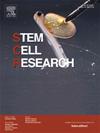Generation of an iPSC line (with isogenic control) from the PBMCs of a COL6A1 (c.1056 + 2T > A) Bethlem myopathy patient
IF 0.8
4区 医学
Q4 BIOTECHNOLOGY & APPLIED MICROBIOLOGY
引用次数: 0
Abstract
To produce an in vitro model of Bethlem myopathy, we reprogrammed the peripheral blood mononuclear cells (PBMCs) of a patient with a heterozygous COL6A1 c.1056 + 2T > A mutation at the exon/intron 14 boundary of the COL6A1 gene to induced pluripotent stem cells (iPSCs). Using CRISPR/Cas9 gene editing, we corrected the mutation to generate an isogenic control line. Both the patient and isogenic control iPSCs show a normal karyotype, express pluripotency markers and can differentiate into cell states that represent the three embryonic germ layers (endoderm, mesoderm and ectoderm). These cell lines will be differentiated and used to explore disease mechanisms and evaluate novel therapeutics for Bethlem myopathy.
从COL6A1 (c.1056 + 2T > a) Bethlem肌病患者的pbmc生成iPSC系(具有等基因控制)
为了建立伯利恒肌病的体外模型,我们对一名杂合COL6A1 c.1056 + 2T >;COL6A1基因外显子/内含子14边界的突变诱导多能干细胞(iPSCs)。使用CRISPR/Cas9基因编辑,我们纠正了突变,产生了一个等基因控制系。患者和等基因对照iPSCs均显示正常核型,表达多能性标记,并能分化为代表三个胚胎胚层(内胚层、中胚层和外胚层)的细胞状态。这些细胞系将被分化并用于探索疾病机制和评估治疗Bethlem肌病的新方法。
本文章由计算机程序翻译,如有差异,请以英文原文为准。
求助全文
约1分钟内获得全文
求助全文
来源期刊

Stem cell research
生物-生物工程与应用微生物
CiteScore
2.20
自引率
8.30%
发文量
338
审稿时长
55 days
期刊介绍:
Stem Cell Research is dedicated to publishing high-quality manuscripts focusing on the biology and applications of stem cell research. Submissions to Stem Cell Research, may cover all aspects of stem cells, including embryonic stem cells, tissue-specific stem cells, cancer stem cells, developmental studies, stem cell genomes, and translational research. Stem Cell Research publishes 6 issues a year.
 求助内容:
求助内容: 应助结果提醒方式:
应助结果提醒方式:


